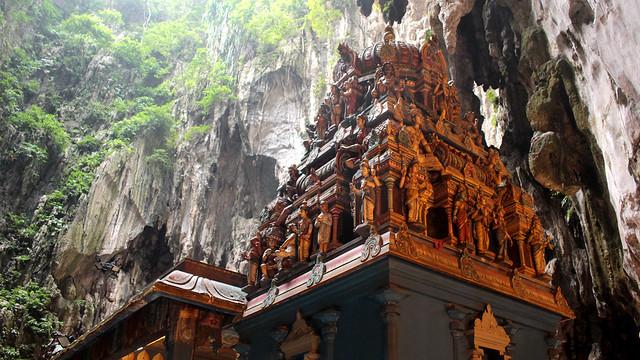Nov 20, 2013
The temples of Batu Caves
F and I visited quite a number of Hindu temples while in Bali, so it was rather interesting to contrast those with the Hindu temples that we typically see in Malaysia. Not only are they architecturally dissimilar, the customs and practices of the devotees also bear differences. Since we saw the Mother Temple of Besakih in Bali, it was apt that we picked Batu Caves as its counter comparison.
Batu Caves is famed for the annual celebration of Thaipusam, taking place early in the year (January/February) to mark the gifting of a vel (spear) by Parvati, the wife of Shiva, to her son Murugan, created by Shiva from the flame of his eye of wisdom. It was this vel that was ultimately used by Murugan to emerge as victor against Soorapadam, an asura who was terrorising the devas. On Thaipusam, devotees from all over Malaysia, following a strict period of cleansing, fasting and preparation, begin a pilgrimage of kavadi bearing. A kavadi is a burden bore by the devotees to be offered to the deity in exchange for good tiding and/or aversion of serious trial and tribulation. It is an absolutely fascinating festival to observe.







Situated 13 kilometres north of Kuala Lumpur, a KTM commuter train of the Sentul-Port Klang route took us straight to the doorsteps of Batu Caves. I can’t tell you the exact fare, since our outbound journey from Bank Negara costed RM1 per person and yet our return journey to the same station was twice the price. Errm… (We bought the tickets from counter each time, as there were technical problems with the ticket machines.)
On exiting the train station, we crossed a gate threshold and to our left, we were greeted by a 15m tall statue of Hanuman along with two smaller temples, which I believe to also be dedicated to Hanuman given the statues found adorning the temples. Hanuman is a vanara (i.e. an ape-like humanoid) who is also a faithful aide and devotee of Rama (the most important incarnation of Vishnu), and traditionally, Hanuman is worshipped as a boundary guardian to keep the area surrounding the temples free from demons and evil spirits.







We continued further towards the main Temple Cave, where a 42.7m gold statue of Murugan holding the infamous vel stands by its entrance. A number of peacocks were observed to leisurely stroll the ground (by the way, peacock is the mount of Murugan) and we also passed, but sadly did not enter, the low-lying Art Gallery Cave that is reported to display multicoloured statues and paintings of Hinduism among a setting of lake and ponds.
Behind the statue of Murugan, a stairway of 272 steps takes devotees and visitors alike up to the Temple Cave. A couple more temples are also found at the foot of these steps, along side some small stalls where vendors sell offerings, good and other small gifts. An ornated tri-portal gate set the stage to begin the upward walk, lined with macaque monkeys eager for food and other shiny objects they can get hold of. They were quite a cheeky lot! (One jumped on F’s backpack and tried to latch on, much to F’s surprise and evoked plenty of laughter around.)







The sight to behold after the moderately energy-consuming walk (although tough for anyone who’s not used to walking in the heat and high humidity) was just awe-inspiring. With ceiling of some 100m in height, temples lining the foot of the cave, and a further sets of stairs towards an open cave and more temples, this makes one very beautiful and natural setting for a temple complex. I debated at one point if this can be equated to the three levels of temple compound like in Bali, but I did not observe the function compartmentalisation that was common in Bali.
Architecture-wise, the temples here are roofed. Not only that, the roofs are also vibrantly coloured and bedecked with various statues of deities, animals, and decorative elements. Certainly, there are parts of the individual temples that are deemed more holy, for only priests are allowed to enter. The bare-footed devotees remain outside a boundary marker while waiting to present their offerings and to receive blessings from the priest.
We lingered around to take in the cave setting, of the limestone formation, of the plants growing along the cliffs and at the summit, of the jagged beauty carved by rain and natural elements. One could imagine the discovery of the caves in the centuries past and how it would have inspired a spiritual search under such elegant setting.







As we descended from the Temple Cave, about half way through and to our right, we veered into the entrance to the Dark Cave. The Dark Cave presents an opportunity to learn more about the science behind the limestone cave formation, of observing natural structures within including stalactites and stalagmites, and to also explore a habitat that is rather peculiar, where total darkness reigns. At one point, we tested our ability to adapt to the lack of light in the heart of the cave and nope, it was not possible to even see my fingers in front of my face! Definitely something worth visiting at least once. (Note: Malaysians can avail of discounted rate by presenting their identity card)
Exiting the caves which were relatively cool, the afternoon heat outside felt searing. We decided to head back towards Kuala Lumpur and to search for our late lunch in a more agreeable environment – within air-conditioned food courts. After all the physical undertaking of the morning, we deserved a cooler break in the city before plotting our next sightseeing moves.













ooooo…monkey silhouette shot is niceeeee
i like the coolness in the cave and the open area at the very top temple…a bit crowded at the bottom area ;)
Indeed it was crowded and far too hot to be comfortable. Interesting place, and I imagine completely packed during Thaipusam!